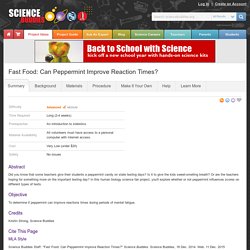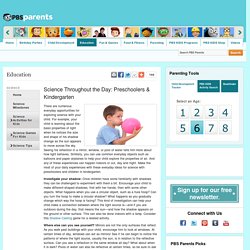

The Top 5 Holiday Science Experiments For Kids. School is out, families are gathering from across the country, and Santa is finalizing his lists.

In honor of the holidays we have created our own list of our favorite Holiday science experiments for kids! The holiday is not just for treats, elves on the shelves, and reindeer; there are a number of science experiments for kids that help them learn and make the holiday time even more fun! Dissolving Candy Canes: We’ve said it before and we will say it again, we love turning the holidays into a learning experience. This experiment teaches your child all about temperatures and how different liquids react differently to the same object. For this experiment you will need: Candy canes (either traditional or SweeTart variety)4 empty jars or glassesVegetable oilVinegarWaterA timer or stopwatch To start this experiment, you will need to fill each jar with 2 cups of liquid. Next, you will want to place the candy canes in the liquids and begin the timer.
How does it work? Borax Crystal Snowflakes: Pendulum Experiment. Eyesg. Fast Food: Can Peppermint Improve Reaction Times? Please ensure you have JavaScript enabled in your browser.

If you leave JavaScript disabled, you will only access a portion of the content we are providing. <a href="/science-fair-projects/javascript_help.php">Here's how. </a> Abstract Did you know that some teachers give their students a peppermint candy on state testing days? Objective To determine if peppermint can improve reactions times during periods of mental fatigue. Credits Kristin Strong, Science Buddies Cite This Page MLA Style Science Buddies Staff. APA Style Science Buddies Staff. (2014, December 18). Share your story with Science Buddies! I Did This Project! Last edit date: 2014-12-18 Introduction Imagine that tomorrow is a big state testing day. In this science fair project, you won't be looking at memory tests, but at reaction time tests, and investigating whether eating peppermint can improve reaction times when a person is tired, or under mental fatigue.
The sensory stimulus does not have to be a visual one, though. Figure 1. Science Experiments, Videos, and Science Fair Ideas at Sciencebob.com. Science Fair Projects for Kids - Easy Ideas, Free List of Fun Topics, Grade, School. Science Demonstrations, Experiments, and Projects.
Get ideas and help with science projects, demonstrations, experiments, laboratory exercises, and other science activities.

Most Popular Projects Try some of the most popular science projects featured at About's Chemistry site. Most of these project use materials commonly found at home. Most Popular Chemistry Demos These are the most popular demonstrations for chemistry class or chem lab. Demonstrations & Experiments Chemistry is fun! Science Magic Tricks A lot of what appears to be magic is really science.
Slime Recipes Learn to make different types of slime, gak, gunk, putty, floam, and ooze. Volcanoes What's chemistry without chemical volcanoes? Glow in the Dark Projects You can use chemistry to cause chemiluminescence, fluorescence, and phosphorescence to make your projects glow in the dark. Make Your Own Chemicals. Kids' Science Projects - Ideas for School Project Experiments. Results for experiments : PBS LearningMedia. Science Archives.
Sally Ride STEM Central. Pre k science projects on Pinterest. Everyday Science for PreK & K . Science Activities . Education. There are numerous everyday opportunities for exploring science with your child.

For example, your child is learning about the basic properties of light when he notices the size and shape of his shadow change as the sun appears to move across the sky. Seeing his reflection in a mirror, window, or pool of water tells him more about how light behaves. Similarly, you can use common everyday objects such as balloons and paper airplanes to help your child explore the properties of air. And any of these experiences can happen indoors or out, day and night. Make the most of your daily experiences with these everyday ideas for science with preschoolers and children in kindergarten. Investigate your shadow: Once children have some familiarity with shadows they can be challenged to experiment with them a bit.
Where else can you see yourself? Exploring balloon power: Partially inflate a balloon and ask your child what she thinks will happen when you let go of the end.